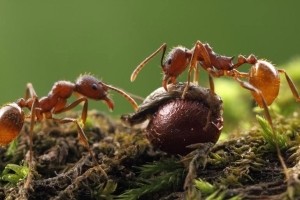
When friends and colleagues hear that we’ve written a book on the ants of New England, their first reaction is always to ask: “I have ants in my ... (kitchen, walls, pants). How do I get rid of them?” It’s a fair question, but if you stay fixated on the little black creatures scurrying out of your sugar jar, you’ll miss out on a wild, wonderful ant world that exists just outside your door. We tell our friends that there are many fascinating species of ants that inhabit our northeastern woodlands, and they’re critical to keeping our forests healthy and growing. At which point they usually nod politely, say something like, “How interesting,” and then ask: “So do the ant traps work? Or should I use the Ant-B-Gone spray?”
To those inclined to see it, ant colonies are a lot like human societies. Ants spend their time running from job to job, take time out for meals, and modify the world around them. Like humans – whose workplaces are divided up into CEOs, middle managers, and technicians – ants are “eusocial” (“truly” social); the labor to keep the colony thriving and profitable is divided up. But there isn’t much upward mobility in an ant colony, where the all-female workforce is organized into castes: some workers tend the brood, some forage for food, and others defend the nest. One or more queens lay all the eggs of the colony while being pampered by their worker-daughters. Unlike the workforce of most corporations, all the workers in an ant colony are sisters, so it is easy to see why they should work together for the benefit of the colony presided over by their queen-mother. Who among us would not lay down her life for her family?
But what about the males? Males are produced only when the colony is ready to begin a new colony – at most, this happens once a year. The winged males live just long enough to mate with virgin queens. An important part of their job is to mix up the gene pool by mating with queens from unrelated colonies. The queens also have wings, and after mating they disperse near and far. When a mated queen finds a suitable home, her wings drop off and she starts a brand new colony.
How Ants Help Our Forests
Human interactions with ants are often confrontational, but it’s important to keep in mind the many things they do that enrich our lives. Consider the soil that underlies our forests and fields and on which all life depends. Soil accumulates as leaves, twigs, branches, and other debris fall, are buried, and decompose into smaller bits. Ants – along with earthworms, mites, nematodes, and fungi – break down large scraps and accelerate soil formation by mixing subsoil with the organic material on the forest floor. Soil scientist and forester Walter Lyford’s work in Massachusetts suggested that soil movement by ants can create an inch of topsoil every 250 years. Likewise, omnivorous ants clean up a lot of carcasses, from dead caterpillars to fallen nestlings, removing them from sight, recycling the essential nutrients wrapped up within them, and blending it all together into fertile soil. In short, it’s the ants that mulch our soils and stock our larders. Perhaps we can spare them a teaspoon of sugar!
Ants help forest plants, too. They disperse the seeds of many of the sedges and spring wildflowers, such as the bloodroot, trillium, violets, Dutchman’s breeches, and gaywings that grace our woods before the trees leaf out. These plants endow their seeds with an elaiosome: a fleshy package of fats, proteins, and nutrients that is a smorgasbord for ants. The ants bring the seeds back to their nest, eat the elaiosomes, and leave the seeds intact to germinate in the nutrient-rich topsoil the ants themselves have created.
Being among the tiniest forest creatures, ants are food for many other insects, as well as spiders, birds, frogs, and mammals: just about anything bigger than an ant will eat one. Black bears feast on carpenter ants when berries are scarce, and woodpeckers drill into trees looking for ants. Even pitcher plants and sundews make meals of ants.
The Diversity of Ants in the Northeast
From a distance, all ants look alike (little red or black things with way too many legs). But peer more closely, and you’ll notice they come in a rainbow of colors: yellow, red, black, and even multi-hued. Some sport lustrous silver or gold hairs; some even have bizarre "skirts" around their abdomens. Northeastern ants range in size from the barely visible (1/25 inch long) to the impressively stocky (over 1/2 inch long).
We have documented over 140 different species of ants living in New England, New York, Québec, Nova Scotia, and New Brunswick. Fourteen of these are non-native, most of which are tropical tramps that only survive New England’s climate by living in basements, greenhouses, and other warm buildings. Other species may move into our region as the climate warms, including Lasius murphyi, Camponotus subbarbatus, Pachycondyla chinensis (the exotic “needle ant” named for its sting), and the prairie ant, Formica dakotensis. Some of the native boreal species, however, may not be able to tolerate the warmer summers we expect to see in the coming years: Formica hewitti, Myrmica brevispinosa, and the aptly named Formica glacialis may all be forced to relocate further north.
Even though amateur and professional ant-geeks (or more technically, myrmecologists) have been collecting ants in New England for over 150 years, we still have a lot to learn about their distribution and habitat preferences. After analyzing nearly 30,000 records from New England ant collections, past and present, we determined that we know much more about the ant fauna of some areas and much less of other areas; even the number of species in the Northeast is uncertain. We are sure that 132 different species have been collected in the six New England states alone, but with reasonable confidence (95 percent), we predict there are at least 21 species yet to be found. We are most confident about our estimates of ant diversity where ants have been most frequently collected: Massachusetts, the Waterboro Pine Barrens and the Down East region of Maine, parts of Connecticut, and around Burlington, Vermont. But gaps in our knowledge are most apparent where ant collecting has been rare: Maine’s Great North Woods, Vermont’s Northeast Kingdom, most of New Hampshire, and Rhode Island.
As you pay more attention to ants, you’ll notice that different ants live in different habitats; some are picky specialists and others are cosmopolitan generalists. Ecologists use these differences to quickly assess changing habitat qualities as forest stands age. Of all our habitats – from beaches to mountain summits – we find the highest diversity of ant species in uneven-aged woodlands that have an assortment of microhabitats: forest edges, patches of open ground, fallen and rotting twigs and logs, and denser stands of aging trees.
Ant species diversity is especially high in forests growing on dry, sandy soils, such as open oak/pine woodlands, scrub oak balds, and pine barrens. Hiding under rocks and nesting deep underground in many of these forests lurk the citronella ants, a unique group of Lasius species. These beautiful, golden-yellow ants are easily identified by the lemony, citronella-like smell they exude when disturbed. They tend herds of root-feeding aphids and related insects, slurping up the honeydew these plant-sucking insects produce (much like the barfly personified by Woody Allen in the movie, Antz). Like many ant species, citronella ants are social parasites on other ants. To found a new colony, the queen first moves into an existing colony of another Lasius species, kills the host queen, assimilates the queen’s odor so she smells like the old queen to the subterranean workers, and begins laying eggs. The duped host workers care for the parasite’s brood, rearing them as sisters. As the host workers die off, they are replaced by the parasite’s offspring, who enlarge the nest. Citronella ant colonies can be enormous, with more than 10,000 workers in a single nest. The colonies produce males in late fall, and many colonies often swarm in synchrony, filling the forest with sweet-smelling ants.
Look under small rocks and downed wood for the winter ant, Prenolepis imparis. Its common name reflects the fact that this species is very tolerant of cold weather – its workers are the earliest out in the spring and the last to disappear in the fall. It is also the only “honeypot” ant in New England: some of the workers store sugars they collect from flower nectar and insect honeydew in their distended abdomens. When food is scarce in the colony, these honeypots (also called repletes) regurgitate this sugar to feed the rest of the colony.
It’s harder to find ants in mature forests. As the canopy closes, the humidity at the forest floor increases and the average temperature drops. Such conditions are less favorable for ants in general, and only a few ant species remain in old-growth hemlock forests. On the other hand, three arboreal species – Camponotus caryae, Aphaenogaster mariae, and Temnothorax schaumi – are found almost exclusively nesting in large (18-inch diameter or larger) oaks, walnuts, or hickories in mature hardwood forests of the Northeast. As old-growth hardwood forests have disappeared from our region, these ants have become quite rare. In fact, out of nearly 30,000 collection records of ants in New England, we know of only one of Aphaenogaster mariae, eight of Camponotus caryae, and 31 of Temnothorax schaumi.
From the Forest to Your Floor
It takes a great deal of exploring for us to find the uncommon woodland ants, but the more common woodland ants have no trouble finding us. The two ants we most frequently see in our region are the ones that end up in our kitchens and walls. The sugar ant, Tapinoma sessile, is better known as the odorous house ant, because it smells like overripe bananas when it is disturbed or pinched. This native ant prefers to nest outside, and the workers marching across your counters are likely following well-marked trails that can extend for tens of yards. They’ll nest indoors, though: under sinks, in the basement, or in an open bag of sugar, wherever there is enough moisture to keep the colony well hydrated. The best defense against Tapinoma is preventive maintenance. Rather than spraying with Raid, just make sure the sink isn’t leaking, the basement is dry, and the sugar is well sealed in a glass jar.
Like the sugar ant, the eastern carpenter ant, Camponotus pennsylvanicus, makes its primary nests outdoors, in dead wood or decaying tree stumps, often as much as 300 yards away from a domicile. Most carpenter ants will not venture into houses, but the common C. pennsylvanicus uses your house as a satellite outpost, established to gain more space, food, or shelter in which to rear more brood. The queen stays outside while the workers move food and brood back and forth in the thin, moist channels next to pipes and wires. Moisture is key: C. pennsylvanicus needs it, and unless your timber frame is beginning to rot, carpenter ants will stay away. So if you see carpenter ants, check the structural integrity of your house – and if you find damage, the ants are most often the symptom, not the cause. Once again, prevention, not poison, is the best means of control. And by keeping the pesticides away from your house, you’ll be able to see many more kinds of ants, too.
So leave the ant baits in the box. When you shoo those ants off your counter and send them packing, follow them outside and back to their nests. Poke around the leaf litter, look under stones or bark, and settle down to watch the wonderful world of ants. As you come to know these hard-working denizens of the woods better, you’ll appreciate all that they do for us and for the forests around us.


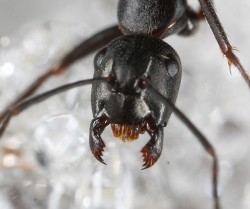

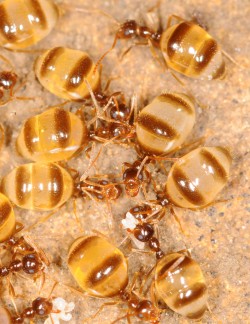
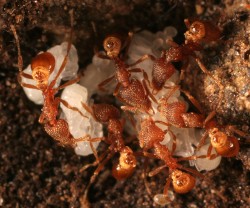
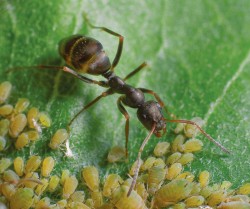
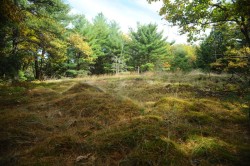
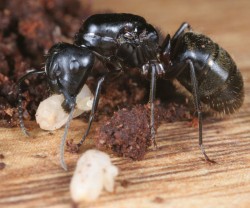
Discussion *